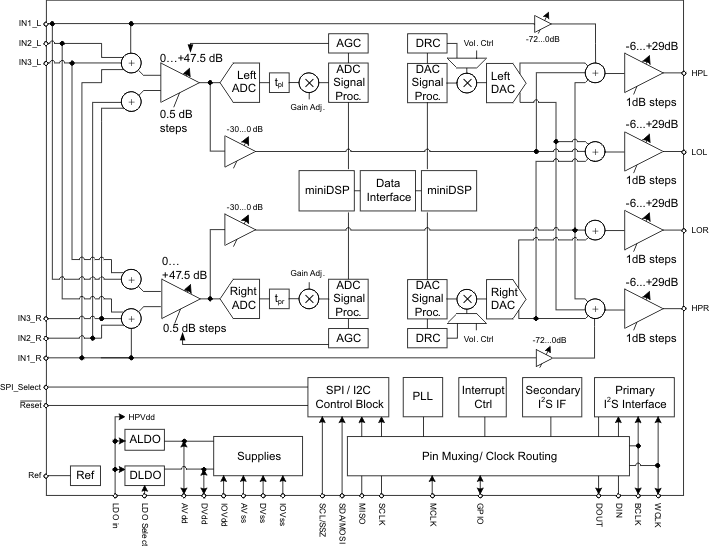SLAS724A September 2008 – November 2014 PCM3070
PRODUCTION DATA.
- 1 Features
- 2 Applications
- 3 Description
- 4 Simplified Schematic
- 5 Revision History
- 6 Device Comparison Table
- 7 Pin Configuration and Functions
-
8 Specifications
- 8.1 Absolute Maximum Ratings
- 8.2 Handling Ratings
- 8.3 Recommended Operating Conditions
- 8.4 Thermal Information
- 8.5 Electrical Characteristics, ADC
- 8.6 Electrical Characteristics, Bypass Outputs
- 8.7 Electrical Characteristics, Audio DAC Outputs
- 8.8 Electrical Characteristics, LDO
- 8.9 Electrical Characteristics, Misc.
- 8.10 Electrical Characteristics, Logic Levels
- 8.11 I2S LJF and RJF Timing in Master Mode (see )
- 8.12 I2S LJF and RJF Timing in Slave Mode (see )
- 8.13 DSP Timing in Master Mode (see )
- 8.14 DSP Timing in Slave Mode (see )
- 8.15 I2C Interface Timing
- 8.16 SPI Interface Timing (See )
- 8.17 Typical Characteristics
- 9 Parameter Measurement Information
- 10Detailed Description
- 11Application and Implementation
- 12Power Supply Recommendations
- 13Layout
- 14Device and Documentation Support
- 15Mechanical, Packaging, and Orderable Information
1 Features
- Stereo Audio DAC with 100dB SNR
- Stereo Audio ADC with 93dB SNR
- Extensive Signal Processing Options
- Embedded miniDSP
- Six Single-Ended or 3 Fully-Differential Analog Inputs
- Stereo Headphone Outputs
- Stereo Line Outputs
- Very Low-Noise PGA
- Analog Bypass Mode
- Programmable PLL
- Integrated LDO
- 5 mm x 5 mm 32-Pin QFN Package
2 Applications
- Soundbar
- Flat Panel Television
- MP3 Docking stations
- Cell Phone Docking Stations
- Other Stereo or 2.1 Home Audio systems
3 Description
The PCM3070 is a flexible stereo audio codec with programmable inputs and outputs, fully-programmable miniDSP, fixed predefined and parameterizable signal processing blocks, integrated PLL, integrated LDOs and flexible digital interfaces.
Device Information(1)
| PART NUMBER | PACKAGE | BODY SIZE (NOM) |
|---|---|---|
| PCM3070 | VQFN (32) | 5.00 mm x 5.00 mm |
- For all available packages, see the orderable addendum at the end of the datasheet.
4 Simplified Schematic
